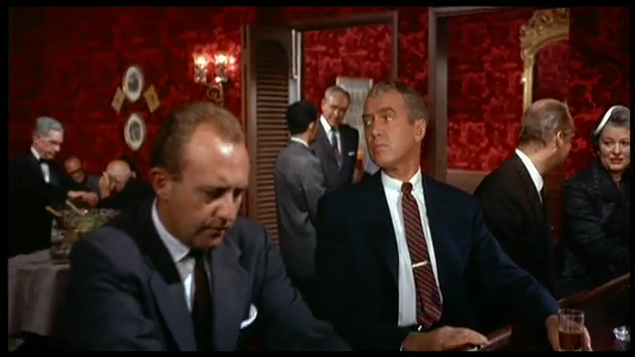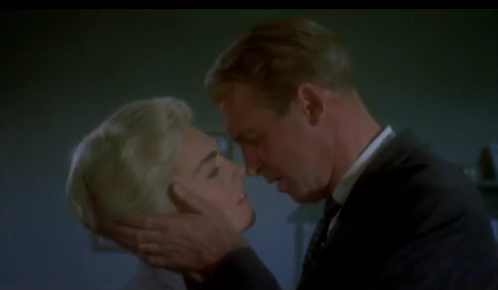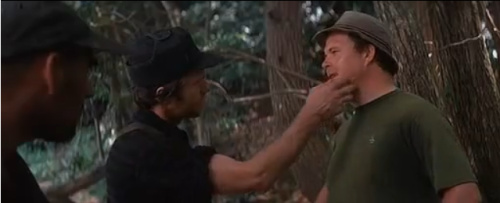
VERTIGO (1958, Hitchcock)
Like the previous post about Scorsese, this shot is staged with great originality and really bares the stamp of the director. Kim Novak’s famous entrance in the film is so simple, restrained, elegant, and full of weight. The placement of the actors, the color design (the colorless extras, the red walls, her vivid dress), the famous music cue, the elegance of the camera movement, all tell you to pay attention, something life-altering is happening to our main character (Jimmy Stewart) – we’re meeting what will become his obsession.
There’s something about this shot that is beyond its design and beyond explanation; simply the effect is greater than the sum of the parts, in my opinion. Especially when you think of all the millions of ways he could have chosen to reveal her, makes you thankful he picked this way!
The Reveal: One of Hitchcock’s specialties
If I had to pick one thing about a shot that I think is most important, it’s the reveal, ie, the surprise, the beat of the story unexpectedly exposed. This reveal here is so brilliant. How can Hitchcock do this with such restraint and yet so obviously? It really engages the viewer – startles you (or at least it did me) – because you feel like you’re spotting something on your own. This is what great filmmaking does, lets the audience deduce and discover on their own.
As with most great stagings/shots, this one works economically on so many levels: Stewart and Novak’s characters become clear, we see he’s an outsider as we learn what world she inhabits, exudes; he’s spying, so are we; we’re also bathing in the sense of supernatural mystery that surrounds her; get a dose of his foreshadowed feelings for her; and experience the gravity both he’s experiencing and that is sneaking up behind her (or so we are lead to believe). And let’s not forget the suspense of the shot, which maximizes the reveal’s impact; this is, after all, Hitchcock we’re talking about. (Thanks to Jeremy Cole for reminding me of this last point in his comment below!)
I’m trying really hard not to swear here to emphasize how much I admire this shot! The whole rest of the clip is awesome, too. How about the light that comes up behind Novak’s head when she strikes a pose? No rule says you can’t. Or the two shots of Stewart, one on his right and one on his left, as she passes him, each conveying a distinctively different moment. Very fine. And then the thematic two-of-her as she passes the mirror! Hitch was into the details.
Behold! Shot starts at :06 –
Next week I’ll do another shot from Vertigo. I wonder if you can guess which one? If you do, I will make the next Vertigo shot the official post of “your name here!“



dave Cotton
very cool
I love this “getting inside your head” on these…
I’m learning lots.
Carlos
I have to admit that Vertigo is NOT one of my favorite films. I do however like the scene you posted. Many times I’ve set up a shot because it looks cool, and other times to set up the mood. I never really plan out a shot that’s shot for shot. (no pun intended)
I also believe that many times filmmakers and people who are very into film, over analyze a shot or composition. I don’t think Hitchcock was the Orsen Wells otype to force a shot to drive a point or like Terry Guilliem who shoot the same shot for hours, to get the hampster to run in a circle.
I think Hitchcock just loved the way stuff looked and said “hey, I think this looks cool, let me try that” if he was mitioculous about a shot, he would’ve made sure that three of the edits flowed flawlessly without a break in continuity.
lol, love you John…just my thought.
jsbfilm
I do think that the better a director grows, the more intuitive feelings they have when a shot works, not really necessarily realizing just how many levels it’s working on. As a filmmaker, I too have had people analyze my work and pull stuff out of it that I never put in there, but what can I say, it’s there nonetheless most times, just as the viewer claims. Though this Vertigo shot I’m sure was very deliberate. He probably understood at a glance that all this stuff was in there, consciously or otherwise.
I can’t imagine what break in continuity you’re talking about, though. Do tell!
Love you, too, kimo.
Carlos
Would love to know what his thinking was when the woman walks out of the room and stops and the shot hangs on a profile. The light on the red wall behind her brightens up. Totally loved it, then there’s a cut a way and when it returns, the shot is darker. Doesn’t have that warm glow in the previous shot. the light on the red wall is out. Then there’s a cut away and the light is back on the wall, only to begin to dim out. That shot always bothers me. Maybe I’m reading more into this than I should.
Perhaps he wanted the shot to hang longer and the shot was shorter? Maybe he changed his mind while editing it and that why there are two cut aways? Maybe they didn’t have light meters back then and the DP didn’t light it exactly the same when they picked up the shot? Who knows? You would think he would’ve reshot that entire sequence giving he’s as meticulous with his shots. I know for a fact that if it were my good friend JSB, he would’ve (A) reshot that whole sequence or (B) made sure he had detailed notes, pictures and a clam shell with a split screen to make sure the shots matched.
OR he’s like me and was running camera too! personally, I would’ve slow mo’ed that bitch in post and made the shot longer! ha! ha!
jsbfilm
Good one, Carlos. I see what you mean. Good catch, though don’t make me go through THAT DAY with such a fine tooth continuity comb!!!
R Poe
Granted, many great moments in films are happy accidents discovered in the editing room, but there’s just no reason to shoot a scene like this with zero dialogue unless you’re trying to tell a lot of story very quickly with music and images.
If this was one of Hitchcock’s early films, I’d say yes, maybe he wasn’t quite sure what he was trying to say until he got to the final edit. But, in his later years, Hitchcock was known for shooting films so tightly that they could only be edited together one way – the way he intended it to be seen.
I think this is ballsy, because (again) there’s no dialogue. And this probably took a whole day to shoot. There’s no bartender leaning over and saying “Hey Mack, why are you staring at that girl?” “You look like you’ve seen a ghost” etc. He’s counting on the story being conveyed with subtle gestures and camera movements.
Nice choice, John.
jsbfilm
Thanks, Rob. Wonderfully stated.
Joe
one of my favorite shots in my third favortie hitchcock (after rear window and north by northwest). love the quick profile match cuts to bond them, followed by them looking off frame left/right. nicely done.
and the elegance of the first move, the glacial pace, and not pushing in too quickly on novak. it’s just the right pace, and our focus shifts to the dress at just the right pace. very nice.
and, it’s probably just me, but the red walls and decor seems almost muted in a way. it doesn’t pop, which i think would’ve distracted from the shot. again, very nice.
jsbfilm
That’s a great observation and a really nice way to put it, Joe – “the matching profile shots that bond them.”
Jeremy Cole
Good points by all! I agree that we do work on more levels than we realize consciously. Ever had a dream that baffled you when you woke but made perfect sense after you had some time to analyze it? I think filmmaking can be similar.
Forgive me if I’m stating the obvious but what I got from the scene was that his shot choices were about his famous voyeurism of course but also (and I think related to the voyeurism) were made with an eye toward using blocking/staging, shot structure and editing to building this halting, “almost encounter.” The more he builds up her allure, the greater the imbalance and tension is in us as, on the other side of the scale, we have Stewart’s desire and lack of action.
He does it from the start with that pan. It’s motivated by Stewart’s gaze but I think he deliberately builds tension by not giving us the subject of the shot for so long. Then he teases it out… her introduction with her back to us/him, the slow reveal of her beauty as she stands, turns… the pause in the doorway giving him a chance to admire her framed there, a chance to screw up the courage… then the turning of their heads, eye lines not quite meeting. The moment slipping away… then around to the other side of him, telling us the chance has passed him by. She’s gone… The net is we empathize with his clashing feelings of desire and nervousness. We hold our breath with him and let it out at the end.
Even if I don’t love every shot choice a director makes, I almost always love to see a bold choice instead of wide, medium, close.
My 2 cents.
jsbfilm
Fantastic! Enthusiastically agree. How could I have failed to mention the *suspense* of this shot… in a post about Hitchcock? Great catch.
Jeremy Cole
I’m honored! Thanks for the shout out.
Reading this over again, I picked up on the comments about lack of dialogue. This reminded me of an anecdote I heard about Leone and Eastwood regarding Fist Full of Dollars. Basically, Leone had lots of dialogue and Eastwood talked him into a more minimalist approach because he realized that talking robs a scene of suspense. It’s the essence of the appeal behind that strong silent type he plays — the man with no name (whose name is Joe 🙂
Just watch the scene where he tells the coffin maker to make three coffins, walks over to the gang real slow – spurs clanging with each step. He stops. Lights his cigarillo. They regard each other for long moments, a few barbs about his mule are exchanged but it’s mostly about the eyes, hands creeping toward guns, reaction shots all building into that pent up explosion of violence. Bang! Bang! Bang! Bang! The smoke clears and we’re back to the clanging spurs as he walks back… “My mistake. Four coffins.”
Now imagine that scene chock full o’ dialogue. Wouldn’t be nearly as powerful. I think some of that same principle applies here. Suspense.
Pingback: VERTIGO part 2 (1958, Hitchcock) « shot4shot
Pingback: VERTIGO part 2 (1958, Hitchcock) | shot4shot